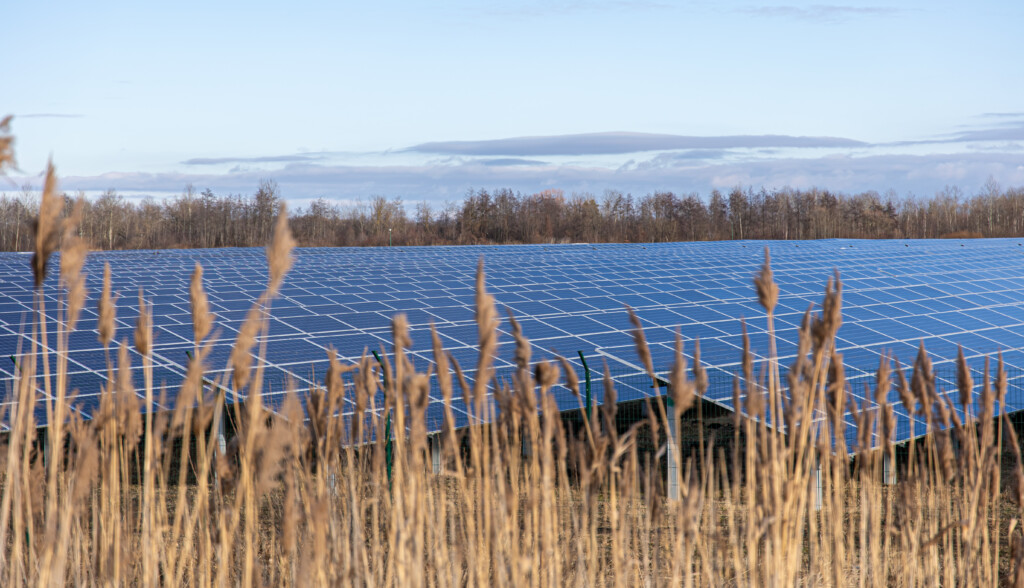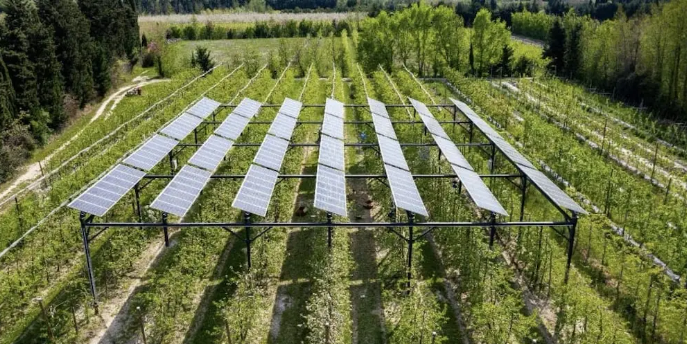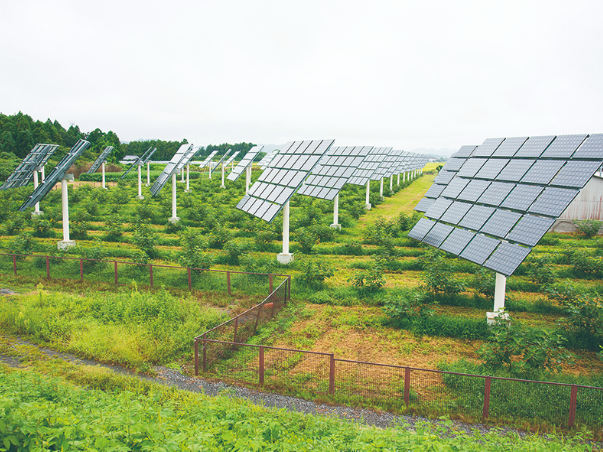As our planet’s population grows and the realities of climate change become increasingly evident, the search for sustainable solutions in energy production and food cultivation becomes more crucial than ever. A promising solution appears in the form of agrivoltaics—a practice that merges the production of solar energy and agriculture on the same piece of land. This practice offers the potential to tackle several global challenges simultaneously, from water scarcity to renewable energy generation and food security. Let’s see what agrivoltaics is, its role in conserving water, and some global applications of this sustainable approach to farming.
According to the Food and Agriculture Organization (FAO), the world’s population is projected to reach nearly 10 billion by 2050, leading to a projected increase in the global food demand by 50% to 60%. This tremendous growth will invariably strain our agricultural resources, and it is evident that we need to produce more food within the next few decades than we have throughout the entire history of humanity. However, the question remains: can our current agricultural practices meet these demands in a sustainable manner?
Agriculture accounts for approximately 70% of all freshwater withdrawals globally. It’s worth noting that the water usage varies significantly by crop type and growing method, but on average, it takes about 2,000 – 3,000 liters of water to produce just one kilogram of rice. For wheat, the number is approximately 1,000 liters, while for maize, it’s around 900 liters. As the demand for these staple crops increases, we must expect a corresponding rise in water usage unless new, more water-efficient methods are employed.
In addition to addressing water scarcity, agrivoltaics can also contribute to improving water efficiency in livestock farming. By reducing heat stress on animals, the shade provided by solar panels can help maintain their health and reduce the need for excessive water consumption for cooling purposes. Around 50% of the world’s habitable land is currently used for agriculture, approximately 37% of which is for crops and the remaining for pasture. As the population increases, the need for more agricultural land will become more urgent. However, with deforestation and land degradation already presenting significant environmental problems, the expansion of agricultural land is not a sustainable or even feasible solution.
Despite the vast amount of land and water dedicated to agriculture, food security remains a major issue. As of the mid-2020s, nearly 690 million people are undernourished globally, a number projected to rise with ongoing conflicts, climate change, and now, the COVID-19 pandemic. On top of this, global food systems are unevenly distributed, with vast quantities of food wasted in some areas while other regions experience shortages. This indicates that simply increasing food production does not guarantee food security. Instead, we need to overhaul the way we produce, distribute, and consume our food.
Compounding these challenges, climate change presents unpredictable and often adverse effects on crop productivity. The changing climate impacts precipitation patterns, temperature averages and extremes, and the occurrence of pest and disease outbreaks, all of which directly affect crop yield. With around 500 million small-scale farms in developing countries particularly vulnerable, it is clear that a sustainable, resilient, and equitable solution is urgently needed.
Agrivoltaics, also known as solar farming or dual land use, is a promising approach that combines agriculture and solar energy production. It’s a farming method that involves the simultaneous use of land for cultivating crops and installing solar panels, thereby maximizing the utilization of limited resources and addressing the challenges of food and energy production. The concept was first conceived in 1981 by Adolf Goetzberger and Armin Zastrow, but it took a few decades to gain traction and realize its potential benefits.

One of the key benefits of agrivoltaics is its potential to optimize land use efficiency. By integrating solar panels into agricultural areas, farmers can make the most of their available land, thereby increasing overall productivity. The solar panels provide shade, reducing evaporation and water requirements for crops, while also protecting them from extreme weather conditions. This can be particularly valuable in regions prone to drought or water scarcity. Additionally, the cool microclimate created by the panels can help to mitigate heat stress on crops, further contributing to improved water efficiency. This symbiotic relationship between solar energy and agriculture creates a more resilient and sustainable system.
The beauty of agrivoltaics extends beyond the dual utility of land. It can also provide shade and cooling for livestock, improving their welfare and productivity. Livestock can graze comfortably under the shade of solar panels, reducing heat stress and enhancing their overall well-being. It also promotes photovoltaic self-consumption, as the energy needs of farms can often be met or even exceeded by the electricity generated onsite. This self-sufficiency not only reduces energy costs for farmers but also reduces reliance on the grid, contributing to a more sustainable energy system overall.
At the core of an agrivoltaic system lies the strategic installation of photovoltaic (PV) panels within a field. This isn’t as simple as merely placing panels anywhere; thoughtful placement is crucial. Panels are typically installed at a height that allows machinery to operate underneath and with sufficient spacing to prevent excessive shading. The aim is to strike a balance between the amount of sunlight and rainfall reaching both the panels and the crops beneath.
Furthermore, these systems are flexible, with livestock like sheep used to manage vegetation beneath the panels effectively. The orientation and design of the panels are also critical. Many agrivoltaic systems adopt solar tracking technology, which adjusts the panel’s position in response to the sun’s movement, optimizing sunlight capture throughout the day.
Another fundamental component of agrivoltaics is crop selection. Not all crops react the same way to the modified light conditions created by the presence of solar panels. Certain crops, like those that thrive in partial shade or require less water, may be more suitable for agrivoltaic systems. Studies are ongoing to identify which crops are the most compatible, considering factors like photosynthetic efficiency, water requirements, and tolerance to different light spectra. Broccoli, lettuce, celery, peppers, spinach, tomatoes, corn, wheat and certain root vegetables have shown to thrive in such environments.
Agrivoltaics doesn’t just revolutionize the energy and agricultural sectors; it has significant implications for water conservation as well. Given that agriculture consumes approximately 70% of the global freshwater supply, any innovation that can alleviate this demand holds immense potential.
A key feature of agrivoltaics is the strategic placement of solar panels above crops. These panels provide partial shading, which can reduce evapotranspiration — the process by which water is transferred from the land to the atmosphere through soil evaporation and plant transpiration. Less direct sunlight on the crops means less water is lost to the atmosphere, leading to an overall reduction in the crop’s water requirements, which can be as high as 20%, according to Enel Green Power.
This can have a tremendous impact in arid regions or during hot, dry periods. In these situations, the shade provided by solar panels can mitigate the effects of drought and reduce the strain on water resources. The added benefit is that the solar panels themselves remain unaffected by the hot conditions, continuing to generate electricity as per normal.
Research has also indicated that the microclimate created by an agrivoltaic system can promote the growth of dew and frost, which can contribute to a crop’s water intake. In effect, the system creates a feedback loop where the panels help to preserve moisture in the soil, reducing irrigation requirements and thereby conserving water.
Not only can agrivoltaics reduce the amount of water needed for irrigation, but the energy produced from the solar panels can be used to power water-efficient irrigation systems, such as drip or precision irrigation. This integration can further enhance the water-saving capabilities of the farm, making agriculture more sustainable and resilient in the face of water scarcity.
The concept of agrivoltaics has taken root across the globe, evidenced by the rise in government support programs. From Japan’s inaugural scheme in 2012, this form of sustainable agricultural practice has gained momentum, spreading to other nations like China, South Korea, France, the United States, and most recently, Germany. The global landscape suggests that the list of countries adopting agrivoltaics will only continue to expand. Here are a few examples of successful implementations of agrivoltaics.

In Piolenc, France, a sophisticated 84 kW agrivoltaic system has been deployed by Sun’Agri. Spanning 280 panels and towering at a height of about 14 feet, this system is positioned over a vineyard. The uniqueness of this model stems from its use of artificial intelligence (AI), which directs the movement of the solar trackers that the panels are installed on. These trackers are optimized to prioritize plant growth rather than solely focusing on maximizing solar production. In instances of severe weather such as snow or heavy rain, the AI adjusts the tilt of the panels to shield the vines. Reports from Sun’Agri indicate that the implemented system boosted the vines’ resilience to heatwaves, averting growth inhibition. Moreover, water demand was reduced by roughly 30%, and there were notable improvements in the quality of grapes, including increased acidity levels and red pigments.

Sun’Agri also oversaw the installation of an agrivoltaic system in an apple orchard in Mallemort, France, showcasing the versatility of this technology across different crops. This system consists of 196 panels, installed approximately 15 feet high. Preliminary studies indicate that the shaded trees’ water stress level was 63% lower than their unshaded counterparts. Additionally, the area beneath the solar panels recorded cooler temperatures, thus boosting solar production.

Over in Iwaki City, Fukushima, Japan, an innovative agrivoltaic solution has been put in place at Agripark Iwaki. With the initial intention to transform the land into a solar farm, the owners ran into government restrictions. As a workaround, they installed an agrivoltaic system above their fig plants, consisting of 75 ground-mounted solar pillars, each holding 25 panels. The design of this system ensures enough light penetration between the solar pillars, allowing for healthy fig growth. According to the owners, the solar panels haven’t affected the fig fruit production, illustrating the compatibility of solar energy production and agriculture. Concurrently, the farm now also generates solar energy, which powers their operations, thereby increasing the overall productivity of their land.

BayWa r.e., a leading player in renewable energy solutions, has embarked on several trailblazing agrivoltaics ventures in the Netherlands and Germany. These experimental projects included a variety of crops such as wheat, potato, celery, blueberries, red currants, raspberries, strawberries, and blackberries. What they observed was that the temperature under the solar panels was typically two to five degrees cooler on hot days than it was with conventional farming methods. This reduced heat stress on the crops, lowered evaporation from the soil, and subsequently decreased water demand. Interestingly, the warmth was better conserved under the panels at night than under the traditional plastic coverings used to protect berries from cold temperatures, indicating a potential pathway to reduce plastic usage in farms.

In Spain, Endesa, with the support of the Enel group, has been developing an innovative agrivoltaic model. Their efforts encompass five pilot projects at various solar plants including those in Carmona (Seville), Totana (Murcia), Valdecaballeros and Augusto (Badajoz) and Andorra (Teruel). In a unique twist, these initiatives incorporate a triad of photovoltaic panels, crops, and even beekeeping. By creating an effective synergy between the agricultural, livestock, and renewable energy sectors, Endesa’s initiative has generated substantial value for the local community.

Enel’s approach in Greece combines sheep farming with solar energy production, a practice that has been fruitful since its initiation in 2016. Even though the Pezouliotika solar plant was not specifically designed for agrivoltaics, the co-location of solar panels and sheep grazing has proved profitable for both sectors. The sheep help maintain the vegetation under the solar panels, protecting the panels from damage and keeping the operational costs low. This natural form of vegetation control also acts as a firebreak, reducing the risk of wildfires. Furthermore, it reduces the need for mechanical cutting or the use of chemical herbicides, thereby preventing potential pollution of the soil and water resources. This strategy has been employed across multiple installations in the country, such as Xanthi in Thrace and Ιasmos (Rodopi) in the north-east.
As these examples demonstrate, agrivoltaics is not a one-size-fits-all solution, but rather a versatile approach that can be tailored to suit local environmental and socioeconomic conditions. It offers a promising model for harmonizing our energy and food systems while actively contributing to sustainability and community resilience.
Agrivoltaics offers a myriad of benefits that can be categorized into several key areas:
Dual Utilization of Land: Agrivoltaics promotes the efficient use of land by enabling it to serve two crucial purposes – food production and energy generation. This dual-use approach maximizes the output of farmland and can be particularly beneficial in areas where land availability is a constraint.
Economic Efficiency: A notable advantage is the significant reduction in electricity costs. Farms typically spend between 1% to 6% of their total operating costs on electricity. Agrivoltaics allows farms to produce their own electricity, potentially reducing their utility bills. This economic relief is particularly important for family-owned farms, which are facing increasing financial challenges.
Water Conservation: Agrivoltaic systems are designed to effectively manage sunlight exposure, preventing crops from reaching their light saturation threshold and thereby reducing their water demands. The shade provided by photovoltaic panels also mitigates soil water evaporation, leading to less frequent irrigation needs.
Enhanced Crop Production: Certain crops thrive under the partial shade provided by solar panels, leading to increased yield. Studies have shown that crops like tomatoes, lettuce, chard, spinach, peppers, and carrots can significantly benefit from agrivoltaic systems, making the farmland up to 70% more productive.
Boosted Solar Power Generation: The cooling effect from plants through evapotranspiration allows solar panels to generate up to 10% more power. This symbiotic relationship suggests that agrivoltaics can simultaneously increase crop and solar energy production.
Revenue Diversification: Beyond crop sales, farmers can monetize the solar energy they generate through initiatives like virtual net metering and solar renewable energy credits (SRECs). This additional income stream offers financial resilience for smaller farms in the face of unpredictable market and climate conditions.
Climate Resilience: Agrivoltaic systems offer a promising solution to combat the impacts of climate change. By moderating the microclimate around plants, these systems can help maintain crop vitality under harsh weather conditions. Additionally, their inherent water conservation characteristics can aid farms to adapt to future water scarcity scenarios.
Advancing Renewable Energy Goals: Agrivoltaic systems align with global and national renewable energy objectives. According to studies, introducing agrivoltaics on just 1% of US farmland could significantly contribute to reaching national renewable energy targets.
As we navigate the complexities of the 21st century — with its pressing challenges of climate change, food security, and energy demands – innovative solutions like agrivoltaics emerge as promising pathways forward. With its potential to enhance agricultural productivity, conserve water, reduce energy costs, and contribute to climate resilience, agrivoltaics embodies a vision of sustainable agriculture that meets our present needs without compromising future generations.
Around the world, from the vineyards of France to the fig plants of Japan, agrivoltaics is gradually proving its worth. Each successful implementation validates its viability and underscores the significance of dual-purpose land use in our increasingly resource-constrained world. While it may not be a one-size-fits-all solution, its wide-ranging benefits suggest it could play a crucial role in many contexts. As our understanding of agrivoltaics continues to deepen and technology evolves, so too will the opportunities it offers. The farmers who choose to harness the power of agrivoltaics are not just making an investment in their own livelihoods, but in the sustainable future of our planet.
Agrivoltaics, also known as solar farming or dual land use, is an approach that combines agriculture and solar energy production on the same land. It maximizes land utilization by integrating solar panels into agricultural areas, providing shade for crops and optimizing resource efficiency.
Agrivoltaic systems strategically place solar panels above crops, providing partial shading that reduces evapotranspiration and water loss. This shading effect decreases the water requirements of crops, making it a valuable approach for water conservation, especially in arid regions or during hot, dry periods.
Yes, agrivoltaics has the potential to address both food security and climate change challenges. By optimizing land use, conserving water, and promoting climate resilience, agrivoltaics can contribute to sustainable and efficient food production while mitigating the impacts of climate change on crop productivity.
Stay a while and read more posts like this
In recent years, Europe has witnessed a remarkable surge in the adoption of solar panels, marking a pivotal shift towards renewable energy. Data from the...
Renewable Energy, Solar Energy, Solar Energy Basics, Solar Technology
“Unlock the Truth: Get the Facts on Solar Energy!” Introduction Solar energy is becoming increasingly popular as a renewable energy source, but there are...
Imagine a world where you’re able to cut your monthly energy expenditure substantially. A reality where your home isn’t reliant on finite,...